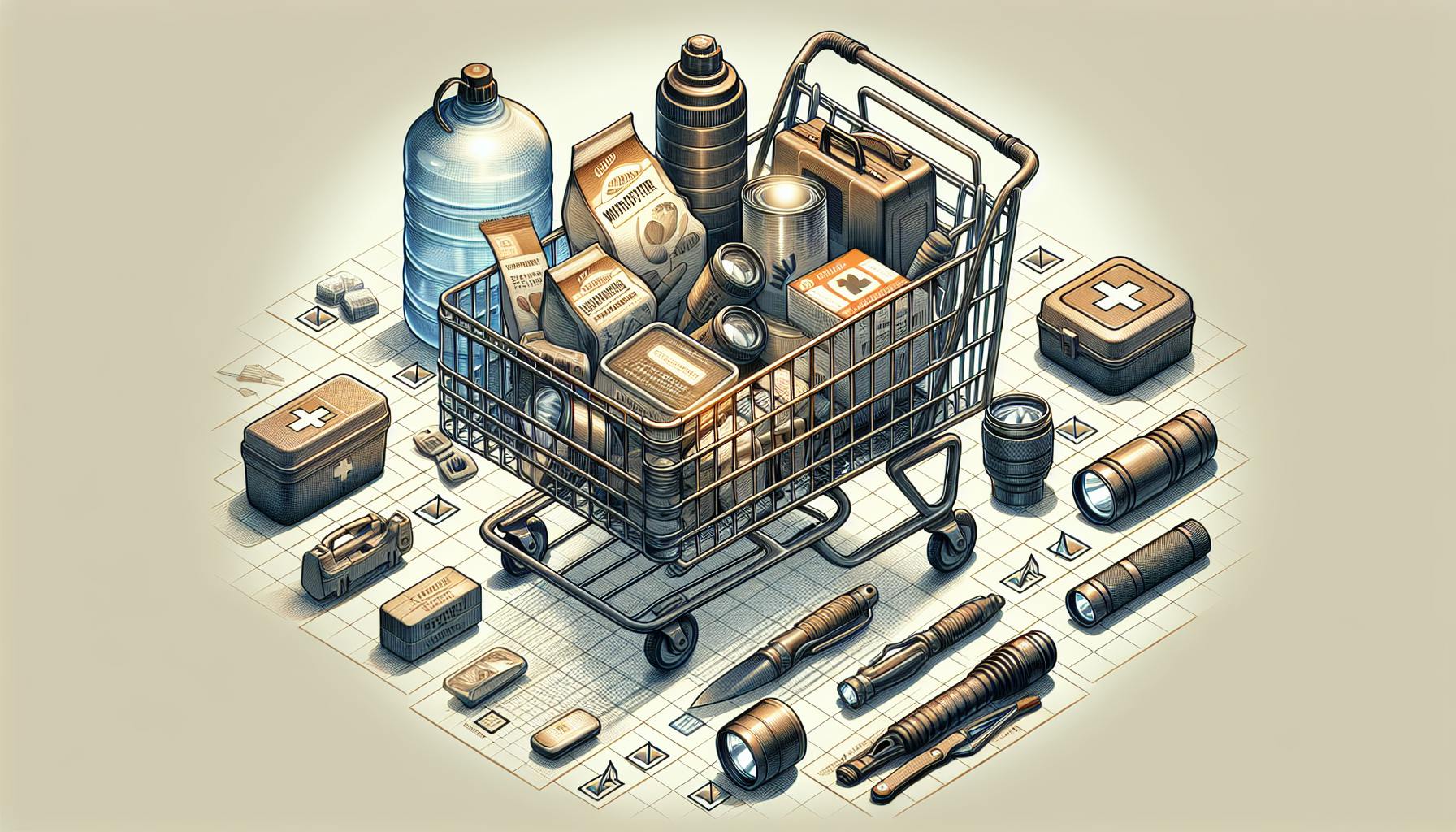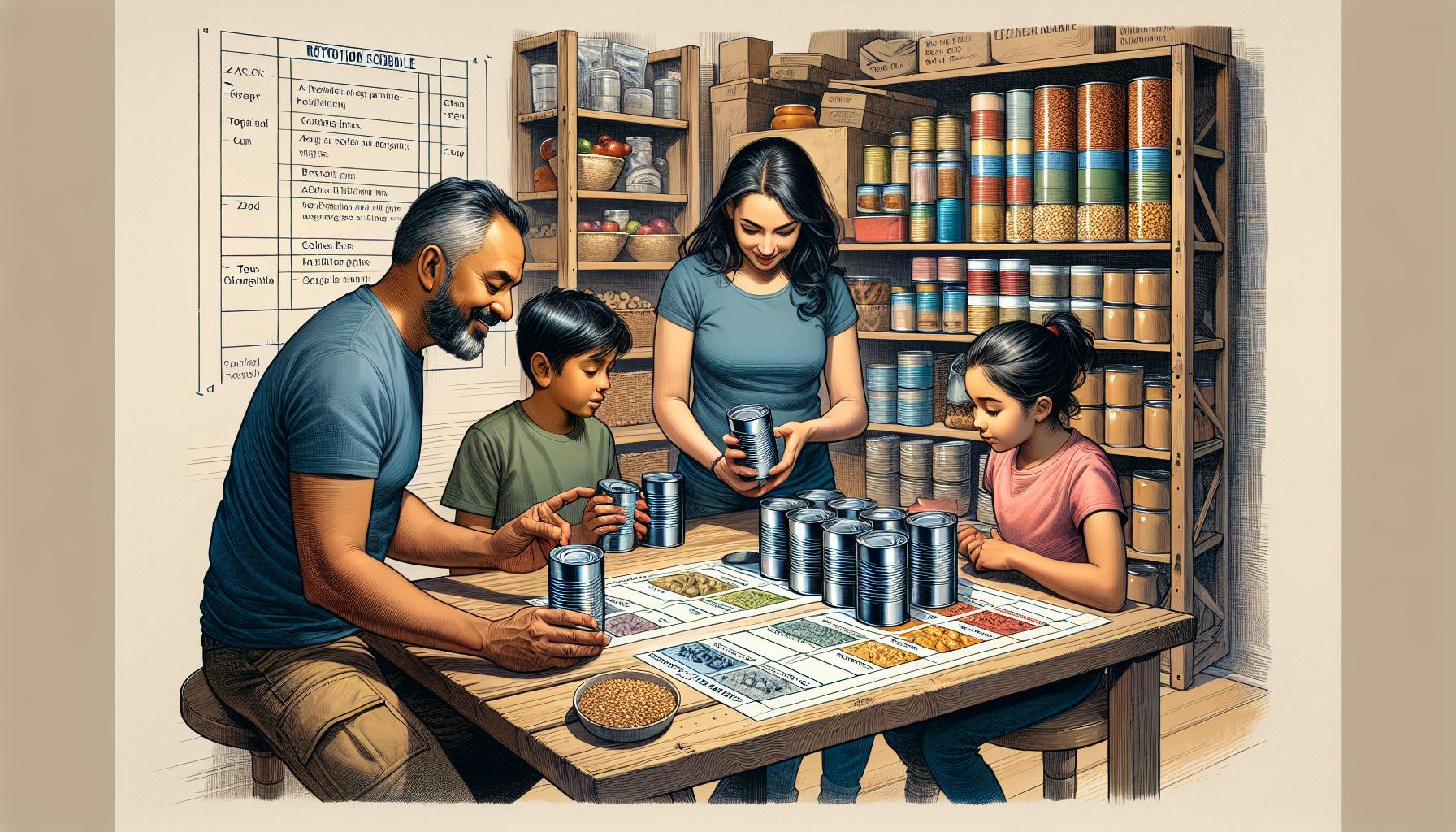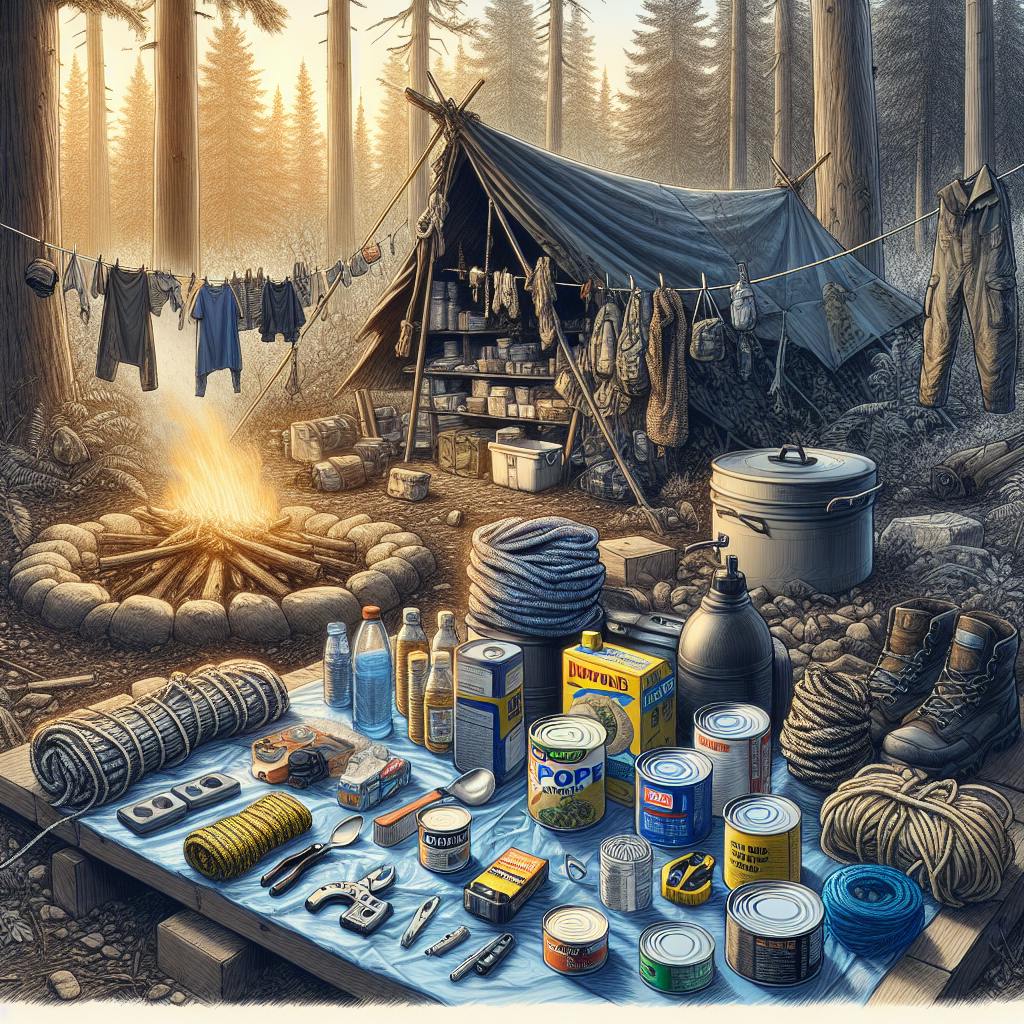Most preppers would agree that having a well-stocked supply of canned goods is an essential part of emergency preparation.
By focusing on shelf life, nutritional balance, and proper storage, you can build an emergency food pantry to sustain your family during difficult times.
In this article, we'll explore the best canned foods to stockpile, how to maximize freshness and shelf life, tips for nutritional meal planning, and final considerations for rounding out your prepper's pantry.
The Imperative of Prepping Canned Food for Survival
Having an emergency supply of canned goods is critical for disaster preparedness. Canned foods have a long shelf life, retain their nutritional value, and are convenient to store and use when needed. Building up a supply of canned meat, fruits, vegetables, and beans provides nutrients and calories when fresh foods are unavailable.
Understanding Prepping Canned Food Essentials
Prepping canned foods refers to stockpiling shelf-stable canned goods as part of an emergency food supply. This includes canned meats like tuna, chicken, and spam as well as fruits, vegetables, soups, and beans. The goal is to have a variety of canned goods on hand that provide protein, vitamins, minerals, and calories to sustain yourself and your family in a disaster when regular food sources are disrupted.
Advantages of Canned Foods in an Emergency Pantry
Canned foods offer many benefits for emergency prepping compared to other preservation methods:
-
Long shelf life - Most canned goods last 2-5 years unopened. Some, like canned meat, can last over 10 years if stored properly.
-
Retain nutrients - The canning process preserves most vitamins and minerals. Canned fruits/veggies have similar nutrition levels to fresh.
-
Affordable to stockpile - Buying canned goods in bulk is budget-friendly. Stock up when sales hit.
-
Easy to store/use - Canned goods are shelf-stable and don't require special storage. They also don't need cooking when opened.
Having canned meat, fruits, veggies, and beans on hand provides reliable nutrition to keep you and your family healthy in an extended disaster when fresh food is scarce.
What is the best canned food to stockpile?
When building an emergency food pantry, focusing on nutrient-dense canned foods with a long shelf life is key. Here are some of the best options to stockpile:
Canned Meats and Beans
Canned meats like chicken, tuna, salmon, and spam provide protein and nutrients. Canned beans are an excellent source of plant-based protein, fiber, and minerals. Aim for low-sodium varieties.
Canned Fruits and Vegetables
Fruits and veggies packed in their own juices or water have a long shelf life. Choose a variety - mixed veggies, carrots, green beans, corn, peaches, pears, etc.
Canned Soups and Stews
Look for low-sodium, high-protein soups and stews. Add canned chicken or beans to boost nutrition.
Canned Milk and Cereal
Powdered or evaporated milk lasts longer than fresh milk. Pair with whole grain cereals for breakfast.
Canned Broths and Sauces
Chicken, beef and vegetable broths add flavor to recipes. Canned pasta sauce, salsa, and coconut milk provide variety.
When building your emergency food supply, strive for nutritional balance across food groups. Track expiration dates and rotate stock. Many canned foods last 2-5 years when stored properly.
How long does canned food last prepping?
Canned foods can last a very long time when properly stored for emergency prepping. According to food safety experts, the shelf life of canned goods depends on a few key factors:
-
Type of food: High acid foods like fruits and tomatoes keep their best quality for up to 18 months, while low acid foods like meat and vegetables can last 2-5 years.
-
Can condition: As long as the cans have no dents, rust, or swelling and have been stored properly, most canned goods are safe to eat indefinitely. However, quality may degrade over longer periods.
-
Storage conditions: Canned goods last longest when stored in a cool, clean, dry place away from direct sunlight and extreme shifts in temperature.
Properly stored canned meat, vegetables, fruits, beans and soups are staples for emergency food pantries. With a long shelf life and easy portability, prepping canned foods enables you to build a survival stockpile that will keep your family fed in emergencies.
When building your prepper pantry, focus on nutrient-dense canned foods like salmon, chicken, beans, tomatoes, and vegetables. Avoid canned goods high in sugar, salt and preservatives. Rotate stock regularly, using older cans first. With some foresight, you can keep your family nourished for months or even years on canned goods alone.
What are four rules for storing canned food?
Here are four key rules for properly storing canned foods:
-
Store in a cool, dry place. Ideal storage temperatures are between 50-70°F. Avoid temperatures above 85°F.
-
Rotate stock. Use the oldest canned goods first and bring newly purchased items to the back. This ensures you are consuming cans before their quality declines.
-
Limit storage time. Try not to store canned foods for more than 1 year, and use canned meats/seafood within 3 years. Quality and nutritional value decrease over time.
-
Inspect cans. Check for signs of spoilage like rust, dents, swelling, or leakage before opening. Discard any questionable cans.
Following these basic guidelines will help maintain canned food quality and safety. Proper storage is key to getting the most out of your emergency food supply. Be sure to integrate new purchases and eat the oldest cans first.
How do I make sure canned food is safe?
Properly sterilized canned food should remain safe and free of spoilage if lids seal properly and jars are stored in a cool, dark place below 95°F. The USDA recommends storing canned goods between 50° and 70°F to best preserve quality and prevent corrosion of cans.
Here are some tips for ensuring the safety of your canned food supply:
-
Inspect Cans Before Storing - Check that cans are free of major dents, rust, or swelling. Make sure lids have sealed properly. Bulging lids or leaking seals can indicate spoilage or contamination.
-
Organize and Date Inventory - Use a first-in, first-out system to rotate stock. Mark purchase dates on cans and jars with a permanent marker. Generally consume canned meat and seafood within 2 years. Most fruits and vegetables last 2-5 years.
-
Store in a Cool, Dry Place - A basement, pantry, or root cellar between 50°-70°F helps prevent corrosion and quality loss. Avoid temperature fluctuations.
-
Check for Signs of Spoilage - Do not consume canned goods that smell bad, foam, or have mold. Ensure safety by boiling suspect cans for 10 minutes before opening. Discard immediately if still showing signs of spoilage.
By following proper sterilization, sealing, storage, and inspection procedures, most commercially canned foods can retain quality and safety for years when stored appropriately. Always use common sense and discard any cans that seem compromised.
sbb-itb-b932644
Best Canned Food for Survival: Building Your Emergency Pantry
Canned goods are an essential component of an emergency food supply. When building your prepper pantry, focus on nutritious and versatile options with a long shelf life.
Essential Canned Fruits and Vegetables
Fruits and vegetables provide vital micronutrients. Prioritize options packed in juice or water rather than heavy syrup.
- Canned tomatoes - Excellent source of vitamin C and lycopene. Can be used in soups, stews, pasta sauces.
- Canned carrots - Packed with vitamin A. Can be eaten plain or added to meals.
- Canned green beans - Nutrient-rich. Can be heated and served as a side dish.
- Canned peaches/pears - Provide potassium and fiber. Choose ones canned in juice.
When buying canned produce, inspect for dents, damage, or swelling.
Protein-Rich Canned Meats for Sustenance
Canned tuna, chicken, and salmon are affordable sources of protein to stock up on. Aim for water- or oil-packed varieties.
- Canned chicken - Shredded or chunk chicken to add to meals.
- Canned tuna - High in protein, omega-3s. Mix with mayo for tuna salad.
- Canned salmon - Excellent source of protein, healthy fats. Eat plain or in salmon patties.
Check expiration dates and ensure proper can integrity.
Canned Beans and Legumes for Balanced Meals
Beans provide fiber, protein, and nutrients. They are versatile - eat plain, add to soups and stews, use in bean salads or dips.
- Canned chickpeas - High in fiber and protein. Use in hummus or curries.
- Canned black beans - Filling addition to chili, tacos, rice bowls.
- Canned lentils - Excellent source of protein, iron, and magnesium. Add to meals.
Rinse canned beans before use to reduce sodium content.
The Role of Soups and Stews in Prepping Canned Food
Keep a variety of canned soups and stews in your emergency pantry. They provide comfort, convenience, and nutrients.
- Canned vegetable soup - Easy meal, packed with veggies.
- Canned tomato or butternut squash soup - Shelf-stable and nutritious.
- Canned beef stew - Protein-rich, convenient meal option.
- Canned chili - Spicy, hearty, and filling.
Look for low-sodium options when possible. Soups and stews last 1-2 years after production date.
When building your emergency food supply, focus on nutrient-dense and affordable canned goods with a long shelf life. Prioritize fruits, vegetables, beans, lentils, meats, soups and stews. Inspect cans before purchase and storage to ensure quality.
Maximizing Shelf Life: The Food Storage Guide for Canned Goods
Properly storing canned goods is key to maximizing their freshness and shelf life. Following storage guidelines can help canned foods last for years.
Optimal Storage Conditions for Canned Food
- Store cans in a cool, dark place between 50-70°F. Temperature fluctuations can impact quality.
- Avoid direct sunlight exposure which can affect taste and nutrition over time.
- Store in a low-humidity area, as high moisture can corrode cans and affect seal integrity.
Implementing a Stock Rotation System
- Use a "first in, first out" system by placing new items behind existing ones and using oldest first.
- Check expiration or "best by" dates before consuming, especially for canned meats.
- Create an inventory list with purchase dates for easy tracking.
Organizing Your Canned Goods: Techniques and Tools
- Categorize by type for easy access - fruits, vegetables, soups, meats.
- Consider an app like FoodKeeper to log canned items and get storage guidance.
- Label cans with purchase dates using a marker for visibility.
- Store cans without bulging, leaks or major dents which can impact safety.
Properly storing canned goods using these tips can extend shelf life for months or years, reducing waste from spoilage.
Nutritional Balance in Emergency Situations: Planning Meals with Canned Foods
Canned foods can provide important nutrients during an emergency, but it's important to plan meals carefully to ensure adequate nutrition. Here are some tips:
Strategies for Nutritional Balance Using Canned Foods
- Combine canned proteins like tuna, chicken, or beans with canned fruits and vegetables to create nutritionally balanced meals.
- Choose canned goods with reduced sodium to limit excess salt intake. Rinse salty items like beans before use.
- Include canned tomato products for vitamin C and lycopene.
- Use whole or diced tomatoes as a base for chili, pasta sauce, or soup.
- Add canned corn, peas, carrots, green beans, and other produce to bulk up meals.
- Choose fruit canned in juice over syrup to reduce added sugars.
Prepping Canned Food Ideas: Recipes and Meal Planning
Here are some canned food recipe ideas that provide balanced nutrition:
- Chili - Combine canned beans, tomatoes, corn, carrots, and canned chicken or beef. Season with chili powder and cumin.
- Pasta with Meat Sauce - Mix canned diced tomatoes, tomato paste, ground beef or turkey, onions, garlic. Toss with pasta and Parmesan.
- Veggie Fried Rice - Stir fry canned corn, peas, carrots, beans with rice. Flavor with soy sauce.
- Bean and Cheese Quesadillas - Mash canned beans with taco seasoning and cheese. Stuff in tortillas and grill.
Create a rotating weekly meal plan to prevent taste fatigue. Incorporate different canned proteins, fruits, vegetables, beans, and grains into each recipe.
Catering to Dietary Needs with Canned Goods
Those with special diets can still meet needs with canned foods:
- Gluten-free - Choose canned meats, fish, fruits, vegetables, beans and certified gluten-free broths.
- Vegetarian/vegan - Rely on beans, lentils, tomatoes, produce, rice, quinoa, chickpeas.
- Diabetic - Focus on lower-sugar fruit in own juice, veggies, beans, lean meats.
- Low-sodium - Rinse pre-made beans/meats before use, flavor with herbs/spices.
- Allergies - Read labels carefully to avoid ingredients like milk, eggs, nuts, etc.
Carefully review nutrition labels on canned goods to fit specific dietary needs and restrictions in emergency situations. Prioritize fruits, veggies, proteins and whole grains as the base of your canned food meals.
Expanding Your Canned Food List: Beyond the Basics
Building up your emergency food reserves takes time and planning. Here are some tips for continuing to expand your canned and non-perishable goods supply over time with a variety of nutritious ingredients.
Setting Goals for Your Non-Perishable Food Supply
Experts recommend having at least a 3-day supply of non-perishable food on hand for short-term emergencies. But many preppers set more ambitious goals:
- 2 weeks - Enough for weather events like blizzards or hurricanes
- 1-3 months - Prepare for extended utility outages or supply chain issues
- 6 months to 1 year - Goal for hardcore preppers planning for long-term SHTF scenarios
Take an inventory of what you currently have and set timeline goals that make sense for your household.
Bulk Purchasing for the Best Prepper Food Reserves
Big box stores like Costco and Sam's Club offer case lot sales on canned meats, fruits, vegetables, and more. This allows you to stock up for the long haul at the best possible prices. Shop their monthly case lot sales and specials.
Online sites like Thrive Life and Wise Foods also offer bulk pricing on freeze-dried fruits, vegetables, dairy items with 20-30 year shelf lives.
DIY Canning: Adding Homegrown Produce to Your Pantry
Learning to can and preserve your own garden harvest is a great way to customize your food reserves. Tomatoes, green beans, soups and stews can all be home canned.
Start with high-acid foods like fruits before attempting low-acid vegetables which require pressure canning. And always use tested recipes and follow proper sanitation procedures.
57 Foods to Stockpile: The Ultimate Prepper's Checklist
A well-rounded emergency pantry goes beyond just staples like beans and rice. Make sure to have foods that provide adequate nutrition, calories, and variety to keep your household healthy in a disaster scenario.
Check out this comprehensive checklist of 57 foods to consider stockpiling, including proteins, fruits and vegetables, meal starters, comfort foods, and more. Cross reference with your current inventory and shopping list.
Prioritizing nutrition, calories, and variety will help your household stay happy and healthy no matter what gets thrown your way. Follow the guidelines here to continue expanding and diversifying your canned and non-perishable reserves over time.
Prepping Your Food for Emergency Kit: Final Considerations
Essential Canned Goods for Your Emergency Kit
When building your emergency food kit, focus on stocking up on versatile, nutritious canned goods first. Top priorities include:
- Canned proteins like tuna, salmon, chicken, and beef. These provide sustaining energy and muscle recovery.
- Canned beans and legumes like black beans, kidney beans, chickpeas, and lentils. Excellent sources of plant-based protein, fiber, and nutrients.
- Canned fruits like pineapple, peaches, pears, and apple sauce. These provide vitamin C, antioxidants, and fiber.
- Canned vegetables like carrots, green beans, corn, and tomatoes. These supply key vitamins, minerals, and phytonutrients.
Ensuring Freshness: Key Storage Tips Revisited
To maximize canned food freshness and shelf life:
- Store cans in a cool, dry place like a basement or interior closet. Avoid temperature extremes.
- Organize by expiration date and routinely check dates, using oldest cans first.
- Wipe away dust and debris before opening cans. Check for dents, rust, or swelling and discard compromised cans.
Combining Canned Goods for Nutritious Meals
Skillfully combine canned foods into balanced, appetizing meals. For example:
- Chili - Canned beans, tomatoes, corn, beef
- Soup - Canned chicken, carrots, peas, broth
- Salad - Canned tuna, pineapple, chickpeas, green beans
Get creative, utilizing spices and other pantry staples to liven up canned food dishes.


